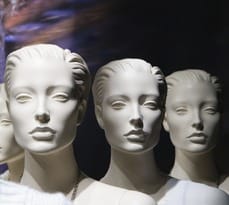
Dr Ben Barry, who recently completed his PhD at Cambridge Judge Business School, has taken as unconventional a route to academia as he did to starting his own business. “I began my own model agency when I was 14 years old in the basement of the family home,” he explains, “and what started as a bit of fun grew into a successful business.”
Brought up surrounded by women – his mother, grandmother and aunt – following the death of his father, Barry developed a healthy view of the nature of beauty. “I remember seeing my then 75-year-old grandmother on the night of her 50th wedding anniversary – in a floor-length ivory gown – and thinking that she was the most beautiful woman in the world,” he recalls.
So when a teenage friend with ambitions of becoming a fashion model was repeatedly rejected because she was the “wrong” size, Barry was not only taken aback, but spurred into action.
“A friend had been told she was too big – she was a size 12,” he remembers. “I wanted to help her, so I sent her pictures to a local magazine and they hired her – and assumed I was her agent.”
Buoyed by his success, over the next 15 years Barry grew his business from one client into a thriving agency with more than 100 models on its books, models who had one thing in common: not their size, their colour, or their age – but their diversity.
“The focus of the company was to promote those models of different ages and sizes – models who looked like my friends and family,” he says. In other words, the kinds of women fashion brands were marketing to, but were ignoring as models.
It sounds simple – and logical – but diversity remains anathema to the fashion industry, Barry believes:
“Most agencies represent thin, young, white women: the standard, idealised model. They may have a few curvy or mature models but it’s not their focus. What’s unique about my firm is its focus on diversity.”
Based on the success of his own business, and what his models and friends told him, he realised the fashion industry might be missing a trick by failing to use more diverse models. “Brands, designers and marketers are very cautious when deciding whether or not to hire diverse models because they are unsure of what impact it will have on the bottom line,” Barry says.
Dove’s famous ad campaign, which used “real women” to sell its skin care products, was extremely successful. In the US alone, it boosted Dove’s sales by 600% in 2 months, yet the fashion industry remains sceptical and fearful of following suit – not least because of the lack of empirical research in the field.
Most research on diversity and the fashion industry focuses on body image and eating disorders but, Barry points out, brands will only be motivated to change the models they use if it sells more clothes:
“What’s missing is that fashion is a business – a $300 billion a year business – so the issue of model diversity needs exploring through the lens of business. I worked in the industry every day and knew it was a real academic research question.”
So, faced with a dearth of studies on the business case for diversity in the fashion industry, Barry set out to conduct his own research. Following an undergraduate degree in women’s studies in his native Canada, and putting his model agency into colleagues’ capable hands, Barry applied to Cambridge Judge Business School. After completing an MPhil in Innovation, Organisation and Strategy, during which he conducted a pilot study, he embarked on his PhD in 2007.
Rather than being puzzled by his focus for research, Cambridge embraced it. “I had unbelievable support and interest,” Barry says. “Cambridge Judge Business School is a really creative place – very open to new ideas and ideas that challenge conventional business practice. Fashion is an under-investigated area, and all my colleagues took it very seriously.”
Models play a key role in fashion advertising, bridging the gap between brands and their consumers. According to Barry, models show “how clothes fit the body and convey a brand’s image and identity. They also convince consumers that their looks and lives will be improved if they buy the advertised product. To achieve this effect, marketers typically cast models that are physically distinct from most consumers.”
For example, the average dress size of international models is a US size 2, compared with the size 14 worn by the average US woman; African-American women make up 13% of the US population, yet only 2.4% of the models used in magazine fashion ads; Caucasian models account for 67% of models in Chinese fashion magazines; and the average age of models is between 15 and 24, even though there are more American and Chinese women aged between 35 and 49 than there are in this model age cohort.
Faced with this mismatch, Barry surveyed 3,000 women in North America and China to discover how consumers respond to fashion advertisements featuring models of diverse sizes, ages and races – in conjunction with different types of advertising copy.
“The main question is how different types of fashion model influence consumer behaviour. That’s the key distinction of this research, that it includes the consumer behaviour variables – consumer intention to buy and scepticism – that impact the bottom line,” he says.
Barry’s research revealed that North American women respond positively to brands featuring models who reflect their size, age and race, and are paired with an “enhancing” advertising copy. By contrast, Chinese women respond favourably when models reflect the Western beauty ideal alongside “problem-solving” copy.
“Our North American findings show consumers increase purchasing intention when offered models who look like them in terms of age, race and size. In China the results are much more mixed and patterns are not as clear,” explains Barry.
“Younger consumers prefer the Western beauty ideal but the more mature prefer Chinese models, although there is a small group of younger women who also prefer Chinese models. It’s a different culture and an economy going through such enormous change that I’m unsure how this will evolve over the next five years. Chinese women might also become fed up with the Western beauty ideal – the unattainable – and there’s also the concern about loss of culture and identity.”
What is clear, however, is that the fashion industry needs to shed its “one size fits all” approach to advertising. According to Barry:
“There is a disconnect between fashion marketers and consumers because the industry is so accustomed to following industry norms about using one type of model. There’s no incentive for them to change. The fashion business is still making money so they’re fearful of casting diverse models.”
The study’s key message is that fashion brands need to change their marketing strategy, casting models that better reflect their target market. If the industry is brave enough to change, the data suggests it could have a major impact on the industry’s bottom line. “I found there is untapped potential in using diverse models,” says Barry. “My research suggests the current strategy of casting idealised models is ineffective. They could unleash enormous economic potential by casting a variety of models that reflect their consumers. Fashion brands have lost touch – now is the time for them to catch up and listen. It’s not about diversity for diversity’s sake but to more closely mirror consumers and increase the bottom line.”
While the results come as no surprise to Barry, his friends and the models on his agency’s books, they are revolutionary for the industry. And Barry has more research up his sleeve. In the autumn, when he takes up a faculty position in the School of Fashion at Ryerson University in Toronto as assistant professor of equity, diversity and inclusion, he will repeat the study in men’s fashion, an important market and one growing even more rapidly than women’s fashion.
His zeal for research seems to echo the entrepreneurial flair he showed as a teenager setting up a business in his family’s basement.
“I’m very excited to have an opportunity to continue this research and bring it into the classroom. My hunch is that the results will be the same, but you never know. It will be fascinating to find out. That’s what’s thrilling about research. You never know what you’ll discover and learn.”


